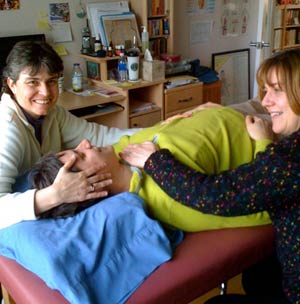 Integrated Manual Therapy® (IMT)
Integrated Manual Therapy® (IMT)
Integrated Manual Therapy® is a functional and structural approach to rehabilitation that works with all of the systems of the body, guiding the homeostasis of the body to a superior level. IMT is a new age method using techniques developed by Dr. Sharon Weiselfish-Giammatteo that addresses your body as a whole to treat pain, dysfunction and disabilities that are preventing your body’s own wisdom from successfully healing itself. This type of therapeutic approach is different than traditional therapies that focus on managing symptoms.
IMT is a non-aggressive method of manual therapy that works to decrease myofascial restrictions and spasm, correct joint biomechanics of the skeletal system and improve the function of the muscular, nervous, arterial, venous, lymphatic and energetic systems.
Structural and Functional Rehabilitation
IMT addresses rehabilitation in two categories: Structural and Functional.
Structural Rehabilitation improves structural integrity of the body. It addresses joint mobility, muscle tone, soft tissue flexibility, range of motion, muscle control and more. It corrects the patho-anatomy in biomechanics of the spine and appendages, muscles, connective tissue system, organs, nervous system, blood vessels, lymphatic system and energetic structures.
Functional Rehabilitation restores functional outcomes according to the optimal potential of the client. It addresses balance, coordination, proprioception (internal joint sensation), exteroception (sensory capability), strength, endurance, hearing, vision, speech, smell, learning, behavior and more.
How it Works
One of the body’s most amazing attributes is its ability and propensity to heal itself. Most health problems, whether acute or chronic, simply come down to blockages and other dysfunctions that prevent various aspects of the body from full recovery and optimal healing. These might be dysfunctions that we are born with or are caused by an accident, injury, or acute/repetitive trauma. Also, the body’s immune and filtering systems can get so overloaded by an environmentally-challenged world and emotional stresses that they can no longer process the build-up of toxins effectively and efficiently. These are just a few of the more common examples.
The fundamental premise of IMT is locating the causes of the dysfunction and reestablishing the body’s natural structural and physiologic function. Once these inherent functions are reestablished, the body’s innate healing abilities also return to an optimal level. This non-invasive philosophy of Integrative Manual Therapy is a true embodiment of the medical oath of “First do no harm.”
While IMT is a hands-on technique, it is distinctly different from other modalities such as massage or traditional physical therapy. Patients remain fully clothed. The treatment process is powerful, yet subtle and non-aggressive.
Integrative Diagnostics
As its name denotes, IMT is about placement of the hands based on a thorough understanding of anatomy, physiology, pathology and utilizing different palpation skills for assessment of the primary dysfunction. Each structure of the body has its own unique circadian rhythm. And example of one of these rhythms is feeling for your pulse. This soft tissue exam will determine areas that require attention. The diagnostic assessment looks at various tissues in the body such as muscles, arteries, veins, lymph vessels, connective tissue, organs, and bone. Integrative diagnostics structurally breaks down the chain of command for dysfunction. The body’s story will begin to reveal itself by exposing the dysfunctional tissues that are creating the localized pain. In some cases, the localized pain is the primary problem. In other cases, it may be an area of protection or compensation for other dysfunctional structures.
Treatment
The techniques IMT offers will help aid in tissue and assist healing on a cellular level. Treatment occurs on a physiological, anatomical, nutritional, and psychological level. IMT addresses these areas by breaking them down into three groups; 1) patho-anatomy which helps improve the integrity of arteries, veins, ligaments, bone, discs and other tissues; 2) patho-physiology which is broken down into a) physical functional medicine (PFM) and b) nutritional wellness. Education on nutritional wellness will help improve the physiology of the body. 3) psychotherapeutic approach (IDAP) which involves IMT techniques to decrease emotional stress. Goals are to attain homeostasis or strengthening the natural circadian rhythms of the structures of the body.
General Information
Integrative manual therapists do not say they heal or get rid of certain disorders. However, we do help these people achieve their goals so they may return to a healthier lifestyle. In many cases, IMT has helped prevent surgery or speed up a person’s recuperation from it. It is important for our clients to achieve optimal health. In order for this to happen IMT practitioners believe it is the client’s responsibility for his or her health care process. We seek to work with other health care practitioners to obtain the best answers for each client.
Diagnoses That Can Benefit From Manual Therapy
The following is a list of some diagnoses that have been helped by manual therapy:
- ACL reconstruction
- Adhesive Capsulitis
- Ankle Sprains
- Asthma
- Carpal Tunnel
- Degenerative Joint/Disc Disease
- DeQuervains Tenosynovitis
- Fibromyalgia
- Fractures
- Headaches
- Herniated Discs
- Irritable Bowel Syndrome
- Iliotibial Band Symdrome
- Knee Pain
- Low Back Pain
- Migraine Headaches
- Multiple Sclerosis
- Neck Pain
- Neuromuscular Dysfunction
- Patellofemoral Dysfunction
- Pinched Nerves
- Plantar Fasciitis
- Reflux Sympathetic Dystrophy (RSD)
- Rotator Cuff Problems
- Sciatica
- Shoulder Impingement
- Spinal Stenosis
- Tendonitis
- Tennis Elbow
- Thoracic Outlet Syndrome
- TMJ Dysfunction
- Torticollis
- Vertigo
- Men’s & Women’s Health
- Whiplash
For more information go to Center IMT.
